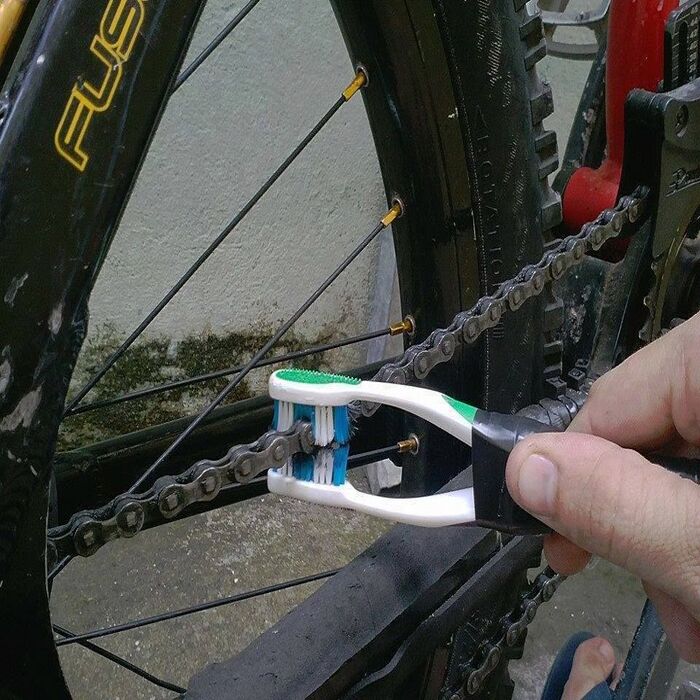Basics of Bicycle Chain Maintenance
Maintaining your bicycle chain is crucial for a smooth ride. Over time, chains collect dirt and debris. This causes wear and tear not just on the chain, but also on your bike’s sprockets and derailleur. Regular cleaning and lubricating can extend your chain’s life. Before starting, ensure you have the right tools. You’ll need a chain cleaner device, degreaser, and a rag. Also, set up your workspace in a well-ventilated area to avoid inhaling fumes.
In your routine, include inspecting the chain for wear or damage. Do this before each cleaning to decide whether it’s cleaning or replacing time. When cleaning, use a degreaser specially formulated for bikes. This will help dissolve grime without damaging the chain’s metal. After cleaning, dry the chain thoroughly before applying lubricant. This prevents rusting and ensures smooth gear shifts. Remember, a well-maintained chain promises a better cycling experience. Don’t skip on this simple yet essential bike care step.

Tools and Materials Needed for Chain Cleaning
To clean your bicycle chain effectively, you’ll need specific tools and materials. Gathering the right items ensures a thorough clean, which will enhance your bike’s performance and extend the lifespan of your chain. Here’s what you’ll require:
- Chain Cleaner Device: A chain cleaner device clamps around the chain. It scrubs away dirt with brushes and a solution.
- Degreaser: Use a bike-specific degreaser to dissolve grease and grime without damaging the metal.
- Rags: You’ll need several clean rags to wipe off the degreaser and to dry the chain.
- Brushes: Small brushes help you to reach into the crevices and clean out stubborn dirt.
- Lubricant: After cleaning, you’ll need a quality lubricant designed for bicycle chains.
- Gloves: Protect your hands with gloves, especially when handling degreaser.
- Water Bucket: If available, use a bucket of water to rinse the chain after degreasing.
- Toothbrush or Old Paintbrush: These are handy for detailed cleaning on the chain and derailleurs.
Before you begin the cleaning process, lay out all your tools and materials. This way, you have everything within reach, and your chain cleaning will go smoothly. How you use these tools is critical, so follow our guide carefully to learn how to clean bicycle chain effectively.
Step-by-Step Guide to Cleaning a Bicycle Chain
To maintain top bike performance, follow this simple step-by-step guide to clean your bicycle chain:
- Position Your Bike: Secure your bike upright or hang it. Ensure the chain is accessible.
- Inspect the Chain: Look for excess dirt, rust, or damage. Replace if needed.
- Apply Degreaser: Use your bike-specific degreaser. Spray or apply it directly onto the chain.
- Scrub with Brushes: Use brushes or a chain cleaner device to scrub off grime.
- Wipe Down the Chain:After scrubbing, use a rag to remove dirt and excess degreaser.
- Rinse if Needed: If you’ve used a water-based degreaser, rinse the chain with a bucket of water.
- Dry the Chain: It’s crucial to ensure the chain is completely dry. Use a clean rag.
- Apply Lubricant: Choose a suitable lubricant. Apply it evenly along the entire length of the chain.
- Wipe Off Excess Lubricant: After a few minutes, remove extra lubricant with a rag.
These steps for how to clean bicycle chain are easy to follow. They will help keep your chain in optimal condition, ensuring a smoother and safer ride.

Lubricating Your Chain After Cleaning
After cleaning your bike chain, lubrication is the next critical step. Proper lubrication prevents rust and reduces wear and tear. Here’s how to properly lubricate your bicycle chain:
- Choose the Right Lubricant: Select a lubricant made for bicycle chains. There are wet and dry lubricants tailored to different riding conditions.
- Apply Lubricant Sparingly: Drip the lubricant onto each roller. Focus on the inner side where the rollers spin around the pins. Avoid over-lubricating to prevent attracting dirt.
- Turn the Pedals: Rotate the pedals backward for several turns. This helps the lubricant spread evenly across the chain.
- Let it Sit: Allow the lubricant to penetrate the chain. Wait a few minutes before wiping off any excess. Short waiting prevents dirt buildup.
- Wipe Off Excess: With a clean rag, gently wipe the chain. This removes extra lubricant that could attract more dirt.
Do this step each time you clean your chain. A well-lubricated chain moves with less friction and performs better. Remember, less is more when it comes to applying chain lubricant.
When to Replace Your Bicycle Chain
Regular maintenance keeps your bicycle chain in good shape, but eventually, every chain reaches the end of its life span. Knowing when to replace your bicycle chain prevents costly repairs down the line. Here are signs that indicate it’s time for a replacement:
- Stretched Chain: Chains don’t stretch like rubber, but the metal wears down, elongating the links. If your chain has elongated by 0.5% to 1%, replace it.
- Poor Shifting Performance: Difficulty in shifting gears or skipping can signal a worn-out chain.
- Visible Damage: Look for bent or broken links. These flaws can’t be fixed and demand a new chain.
- Excessive Dirt and Rust: While dirt is expected, a chain beyond cleaning should be switched out.
- Riding Intensity and Duration: The more you ride and the harder you push, the sooner you’ll need a new chain.
Inspect your chain regularly and compare its condition against these signs. When in doubt, a bike shop can measure chain wear precisely. A new chain maintains your bike’s performance and ensures the longevity of other drivetrain components. Make it part of your regular bike care routine.

Common Mistakes to Avoid During Chain Maintenance
When you’re learning how to clean bicycle chain, it’s easy to make mistakes. Avoid these common pitfalls for effective maintenance:
- Skipping Inspections: Always check your chain before cleaning. Missing signs of wear can lead to damage.
- Using Incorrect Lubricant: Not all lubricants are the same. Choose one that suits your riding conditions.
- Over-lubricating the Chain: Too much lubricant attracts dirt. This can increase wear and tear.
- Neglecting to Wipe Off Excess Lubricant: Failure to remove extra lubricant can create a sticky buildup.
- Ignoring Dry Time: After cleaning, ensure the chain is dry before lubricating. This prevents rust.
- Forgetting to Clean the Derailleur: Dirt and grime on the derailleur can affect shifting. Clean it as well.
- Using Harsh Degreasers: Some degreasers can damage the chain’s metal. Use bike-specific products.
Remember, the right technique and care will extend your bicycle chain’s life. Steer clear of these mistakes to maintain a smooth ride.
Advanced Tips for Long-Term Chain Care
After mastering the basics, enhancing your knowledge with advanced tips can ensure your bicycle chain lasts even longer. Keep in mind these points for long-term care:
- Check for Wear Regularly: Measure your chain wear every few months to assess if it needs replacing sooner.
- Correct Storage: Store your bike in a dry area to prevent rust and avoid leaving it outside in the rain.
- Monitor Lubricant Condition: Over time, lubricant can become less effective. Check and reapply as necessary.
- Use Quality Products: Invest in high-quality lubricants and degreasers for the best maintenance results.
- Proper Tension: Ensure your chain is not too tight or too loose. Both extremes cause wear.
- Regular Professional Checks: Take your bike for an annual service to catch any issues early.
Implement these tips, along with regular cleanings, to maximize the life and performance of your bicycle chain. Remember, diligence in maintenance is key to a long-lasting and reliable ride.


